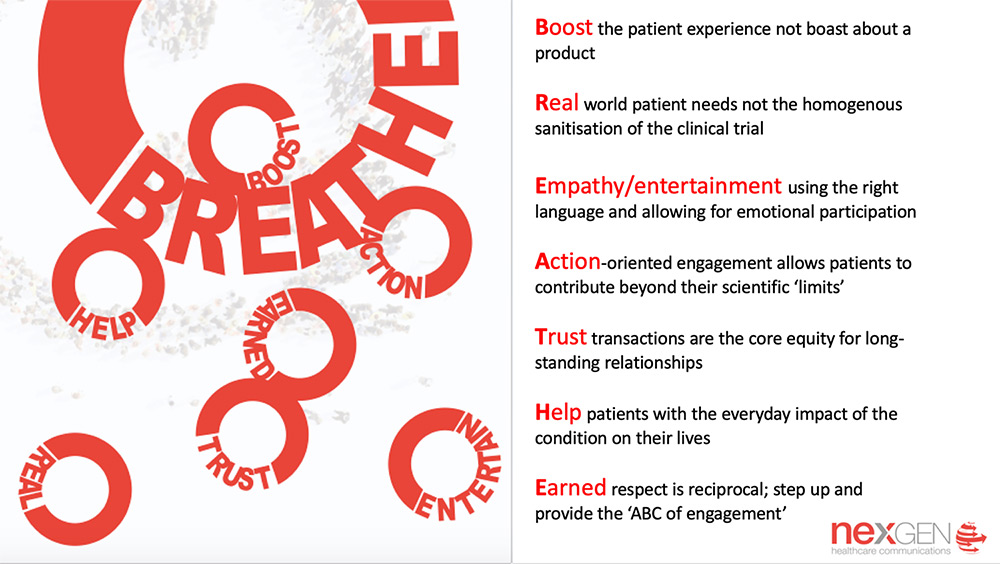Excuses, Excuses, Excuses: The “LingoBingo” of Patient Engagement
Nexgen Healthcare Communications, UK
mproving patient engagement (PE) is a key endeavour for the pharmaceutical industry. Companies have embarked on a plethora of internal and external silo-breaking activities and partnership-seeking opportunities with patient organisations (POs). There are multiple case studies and examples of “good patient practices” (GPAT) in place. Complementing (or perhaps compounding) this are the regular industry events, publications, and overall publicity about PE. It would be easy to assume that the relationship between most pharma and POs is now a great one — underpinned by trust, measured by collaboration, and linked with a common language. However, inertia still prevails that can frustrate and undermine the success of longer-term partnerships in some companies.
In 1995, my first medical writing project was a video for a European patient group describing how the new protease inhibitors worked to (eventually) near-eradicate the HIV virus that was confounding patients, physicians, and pharma. Five intense years followed, filled with many medical conferences, one-to-one sessions with prestigious medical and patient leaders, and research labs in several pharmaceutical companies. The collaboration was intense, focused, and demanded an intimacy between all parties that transcended the formalities of “you patient; we pharma.” This was a no-nonsense era; the language, the expectations, and the results were shared, and they were breathtaking. The “BREATHE” principles (Figure 1) were developed, to enable pharma to look at the life of a patient through the patient’s eyes. This, in turn, evolved into the Halogen Audit – a seven-domain audit to establish PE infrastructures across an organisation from early R&D to long-term services. There are several guidance tools like this for our sector to collectively keep improving partnerships.

Figure 1. “BREATHE” principles enable the pharmaceutical industry to look at the life of a patient through the patient’s eyes. (Published in HealthManagement.org.)
Irritatingly, however, excuses for inertia in patient engagement have started to creep back into our practices. Industry and PO partnerships remain delicate, and where some areas of engagement strive forward, others struggle to take the right steps. To understand this hesitancy, we went through case studies and dissected interviews with more than 40 pharmaceutical or biotech companies and POs or Patient Opinion Leaders who have participated in Halogen Audits. We also launched a social media campaign, “Lingo Bingo,” inviting all experts to help us identify pockets of inertia.
From this project, we are starting to see that the most frequent excuses for inertia in patient engagement can be segmented as follows:
- Compliance concerns regarding promotion versus discussion of product data.
- “I’m not allowed to talk to patients.”
- “We can’t promote our products to patients.”
- “It’s too risky.”
- Ineffective reimbursement systems.
- “We can’t pay patients to come to our meetings.”
- “We don’t have a protocol for this.”
- “I don’t have any budget.”
- Reluctance to perceive patients as experts.
- “It’s more important that we understand the disease.”
- “We can’t invest in patient engagement until we get phase 2 data.”
- “We’ve done patient journey mapping”
- “My condition affects me every day; not just when your latest data comes out.”
- “It’s always the same people invited to the meetings with pharma.”
- “Pharma says ‘talk to us’ but it takes too long to get answers.”
- “Keep me in the loop; don’t make me run in your process circles.”
The most frequent complaint was: “So you can pay a ‘doctor expert’ for their time, but you can’t pay me to tell you about my experience?”
Identifying the inertia and calling time on the excuses for poor or stagnant patient engagement is part one of this LingoBingo exercise. Continue to watch Global Forum for the second part of the story – the actions needed to take us forward faster for the next decade of patient engagement.

